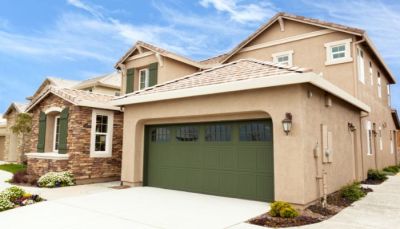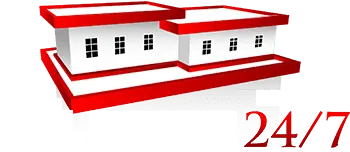Stucco Siding: Definition, Benefits, & Costs

Stucco siding is one of the most popular exterior siding options and a must-have feature in classic Spanish and Mediterranean architecture. The influence and stucco retro finish is present in modern architecture and exterior design, and the demand for stucco siding for 2022-2027 is expected to grow massively. Also, apart from the aesthetic features, stucco siding is a highly durable option for your facade.
However, stucco siding has some downfalls, such as the costs and difficulty in repair. Many DIY enthusiasts tried to repair stucco but ended up in an even bigger mess. In this article, we’re discussing what is stucco siding in detail, stucco siding panels, what makes it difficult to repair independently, its advantages and disadvantages, and the costs.
What is Stucco Siding?
Stucco siding is a retro siding option that is a derivative of Mediterranean architecture. The cement-like texture that bonds well with many understructures, including brick, block, wood, etc., makes stucco a durable material.
Traditionally, stucco siding contains sand, water, and lime from the Mediterranean. When mixed, the texture is applied directly to the exterior of a house to dry and bond with the understructure. Depending on the homeowner’s preferences, the finish can be rough or smooth, but smoother finishes require multiple coats of stucco.
Once dried, your house gets the final and permanent look. Depending on your preference, you can further add ornaments. However, before we get to the ornaments and final looks, you should know all your options for exterior stucco siding.
Types of Stucco Siding
If you search for stucco types, the internet will throw you various articles with numerous “types” of exterior stucco. Some of the most popular names are float or finish, lace and skip, dash, Santa Barbara, and English – the list goes on. However, these are not exactly “types” but finishes that can be achieved by adding more or fewer coats of stucco. Otherwise, you can find stucco as traditional and synthetic.
Traditional Stucco Siding
The traditional stucco siding includes only water, sand, and lime. Nowadays, exterior designers recommend adding Portland cement ideally to the mixture for long-lasting results.
Before the cement-like mixture is applied to the walls, the exterior workers will prepare the understructure of the building by adding paper and a twofold/threefold lath (wire mesh). However, if the base is made of mason, there is no need for paper and wire mesh below.
The stucco goes directly to the mason or the construction cloth, and there are several layers:
- “Scratch layer” is the first layer, which will be the base for the other layers.
- “Brown layer” is the second layer, and it boosts the structure’s firmness and prepares it for the final layer.
- “Finish layer” is the final layer that has a different application method, as experts spread the stucco with a hand trowel that allows them to play with the texture and design for the final look.
Synthetic Stucco Siding
Warmer and hot climates work better with traditional stucco siding. Humid does not work well on stucco as it is a breathable material, and water can easily penetrate and cause cracks. However, synthetic stucco, also known as the “Exterior Insulation and Finish System,” includes synthetic polymers. These replace the cement and lime to provide better insulation, protection from water, and flexibility to use in all climates.
Synthetic stucco has a different approach and application process compared to the traditional one. Here, the initial stucco coat tops the base made of foam board and fiberglass mesh.
Synthetic and traditional stucco have different looks. The synthetic stucco is thinner, water-resistant, more insulated and flexible, and definitely more expensive.
Benefits of Stucco Siding
There are many advantages that come with stucco siding, which are probably the reason for the high demand on the market. Here are some of the most distinct features of stucco siding.
Sustainable Material
Stucco Manufacturers Association calls stucco siding one of the most sustainable materials with years of proven success. With proper maintenance, it is likely to endure more than 50 years without any costly repairs.
Sound-Proof Material
Applying stucco requires blocking every opening of the house’s understructure, including cracks where sounds pass. However, as the worker applies the layers of stucco, all the cracks get blocked, which results in sound proof. The thicker the layer, the better the insulation.
Fire Resistant Material
Stucco siding is fire-resistant because it contains incombustible materials. Portland cement, lime, sand, water, and lime are all fire-proof materials that make the stucco siding a fire-resistant siding, too. Moreover, stucco keeps interior walls safe from fire for the duration of about 1 hour.
Super Flexible Material
Stucco is a material that goes along any architecture type and sustains corrections without losing its original quality. Additionally, it fits well with any type of decoration, which allows you to experiment with the designs and get a fresh look at your house.
Breathable Material
Thanks to the natural materials used, stucco is a breathable material that prevents the occurrence of fungi or molds. For a material to endure more than 80 years and appear in modern architecture, experts inform us that the secret is in the maintenance.
Stucco Siding Maintenance Tips
Stucco siding is known as a low or maintenance-free material. However, experts suggest that routine maintenance is what makes the material durable. Otherwise, part of the routine maintenance is inspection for small hairline cracks on the siding and proper cleaning.
Usually, if you spot small cracks, you need to seal them with sealant as soon as possible to prevent further damage. However, if you notice larger cracks, do not try to fix them on your own. You will have to make the cover exactly the same as the original and plus detect the origin of the crack. In this case, it’s best to call a professional.
As for the cleaning, you need to remove all the dirt that piles over time. However, use softer tools whenever you can, and if you need to brush tougher, use a medium bristle scrub brush with soap and water. Make sure that you don’t scrub too hard using too much pressure, as you may destroy the stucco.
If you make a mess or you need more help than regular routine maintenance, make sure to call experts to repair the stucco. Otherwise, you’re risking the durability of the material.
Cost of Stucco Siding
As mentioned, stucco is considered one of the most expensive siding options. The same goes for stucco repair. The average stucco siding cost is around $8 per square foot in 2023. The highest cost is $9, and the lowest is $6. You should expect to pay for labor and materials additionally. In other words, the average cost for stucco siding goes between $8,000 and $11,000.
Stucco repairs are also salty. According to Home Guide, the average cost of stucco siding repair per square foot is $5 – $50, while the average total price for stucco repair is $150 – $500.
However, it’s important to note that a well-installed stucco panel siding, or any siding at all, will cost you only once in your lifetime. The classic Spanish looks from the previous century are still there as proof that stucco is a high-quality material.
If you consider stucco for your house exterior, make sure you contact an expert team. AA Brite is a highly professional and licensed Tucson-settled company with 20 years of experience in exterior housing. We are a team of highly skilled experts who will get the job done right and for an affordable price. We are available for any questions or dilemmas you have. Feel free to contact us, and we will provide you with a cost estimate for a properly installed stucco siding.
Stucco Siding: Key Takeaway
Stucco is a long-lasting, classical, and versatile exterior siding option. You can choose between traditional and synthetic stucco siding. The traditional recipe is recommended for warmer climates, whereas the synthetic is recommended for colder climates.
The costs of stucco siding can be considered an investment, but given the results, and proof of the material’s durability, we can conclude it’s worth every penny. Routine maintenance is a must to extend the life of stucco siding.
FAQ
What is the biggest problem with stucco?
Stucco is difficult to repair. There are many guides for enthusiastic DIY-ers that explain the repair of stucco siding step-by-step. However, in most cases, the final results of the home stucco repair are an even bigger mess. If you notice a crack or discoloration on your stucco siding, do not act on your own unless you work with stucco. If you don’t, make sure you call the experts.
Does stucco siding increase home value?
Stucco significantly increases the home value, given that it is durable, easy to maintain, versatile, and aesthetically pleasing.
Is stucco better than wood siding?
Yes. Unlike wood siding that is susceptible to rotting, synthetic stucco is highly durable.
When should I replace the stucco siding?
If your stucco panels show signs of mold, get crispy, and fall apart, it’s time to replace them altogether.

